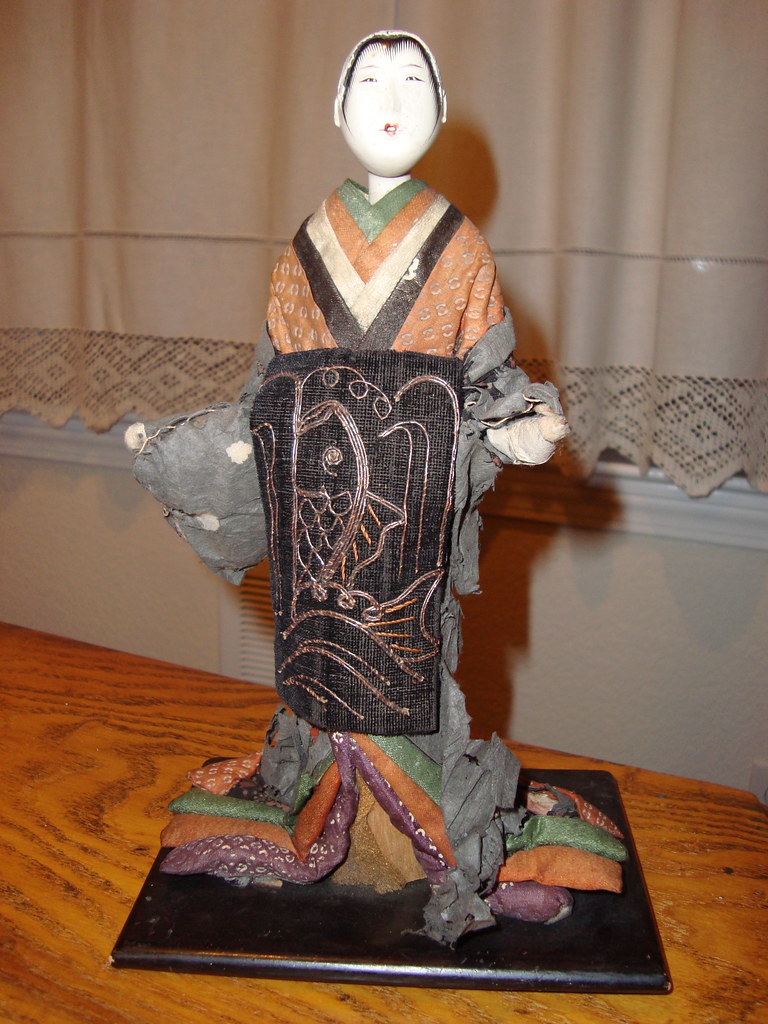 I bought this doll for about 10 dollars online. I was struck by her age--she was probably made in the late 1700's and she represents a Tayuu, or a courtesan in Edo period Japan. ie, a "Classy Hooker." This type of doll is fairly rare, and it's a pity she's in such a bad shape. Since I don't really want to sell her, I've decided to try to restore her kimono. The beginning step here is to figure out how she's constructed by taking her clothing off and documenting it.
I bought this doll for about 10 dollars online. I was struck by her age--she was probably made in the late 1700's and she represents a Tayuu, or a courtesan in Edo period Japan. ie, a "Classy Hooker." This type of doll is fairly rare, and it's a pity she's in such a bad shape. Since I don't really want to sell her, I've decided to try to restore her kimono. The beginning step here is to figure out how she's constructed by taking her clothing off and documenting it.I've decided that the lower layers of her kimono are in good enough shape to save, so I'm going to try to preserve them. You can see most of her clothing is silk, except for her obi, which is velvet (probably imported). Her obi is slightly crumbly but in better shape than her outer kimono. The bottom-most robe, which is visible only in a small triangle at the bottom beneath her outer robes, is made of yellow chirimen and you can see it if you look closely at the above pic.
Here's a surprise! Do you see that black bit with the yellow and red dots
 on it? That's the *real* outer kimono. The blue papery substance next to it is the backing of the original black outer-kimono, which has been sewn to the inside of it to give it strength and form. Most of the damage on this doll isn't bugs or physical damage, although there is a bit of bug damage to the blue lining, as you can see.
on it? That's the *real* outer kimono. The blue papery substance next to it is the backing of the original black outer-kimono, which has been sewn to the inside of it to give it strength and form. Most of the damage on this doll isn't bugs or physical damage, although there is a bit of bug damage to the blue lining, as you can see.It's that the outer kimono was originally dyed black. This early black dye has a
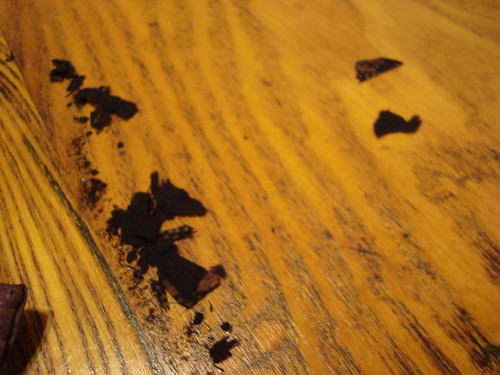 tendency to dissolve the fabric beneath it over time, resulting in many dolls from the Edo period being left with only their paper kimono-linings. As I started removing the lining, the remaining fragments of black fabric crumbled to dust The paper lining is Japanese Washi paper which is hard to tell from fabric. It seems to have been sewn in the same exact pattern as the original kimono so I'll be using the remains of it to create my pattern.
tendency to dissolve the fabric beneath it over time, resulting in many dolls from the Edo period being left with only their paper kimono-linings. As I started removing the lining, the remaining fragments of black fabric crumbled to dust The paper lining is Japanese Washi paper which is hard to tell from fabric. It seems to have been sewn in the same exact pattern as the original kimono so I'll be using the remains of it to create my pattern.Here's some of the "powder" that is all that remains of the black outer-kimono.
I started removing the outer kimono, which is sewn on to the layers at the bottom. These are also backed with paper,
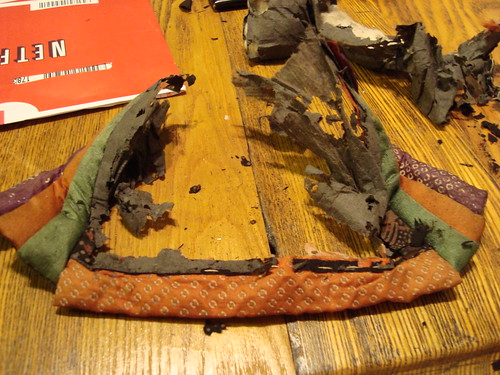 and the inner kimono, instead of actually being full robes, are just a facimile stuffed with cotton batting and sewn onto the outer kimono. Instead of being a full unit, the kimono is comprised of a top and a bottom. The bottom is wrapped around the base and glued into place. The obi covers the join between the top and bottom halves.
and the inner kimono, instead of actually being full robes, are just a facimile stuffed with cotton batting and sewn onto the outer kimono. Instead of being a full unit, the kimono is comprised of a top and a bottom. The bottom is wrapped around the base and glued into place. The obi covers the join between the top and bottom halves.Here's the bottom half, glued to the base. You can see that the base is just a wooden dowel...the clothing gives the doll shape. You can see that around the doll's waste, the kimono is folded back to hold it open in the front in the style of the Tayuu. You can see that the fabric is held in place by a bamboo peg. I'm not sure why this was necessary.
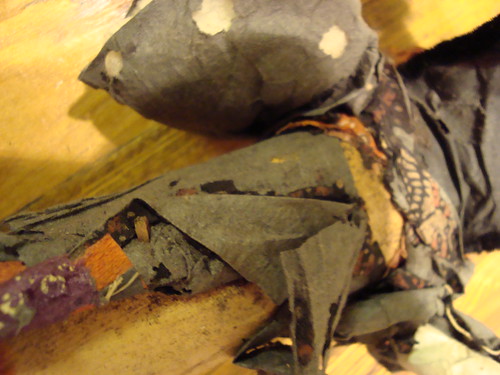 The pillow shape at the top is the doll's right sleeve. It's stuffed with batting and has bug-holes in it. You can also see the original black outer-kimono at the right of the picture where it has been held in place by the velvet front of the obi, which I'm lifting up. You can also see a gap between the top and the bottom, which is again covered by the front of the obi.
The pillow shape at the top is the doll's right sleeve. It's stuffed with batting and has bug-holes in it. You can also see the original black outer-kimono at the right of the picture where it has been held in place by the velvet front of the obi, which I'm lifting up. You can also see a gap between the top and the bottom, which is again covered by the front of the obi.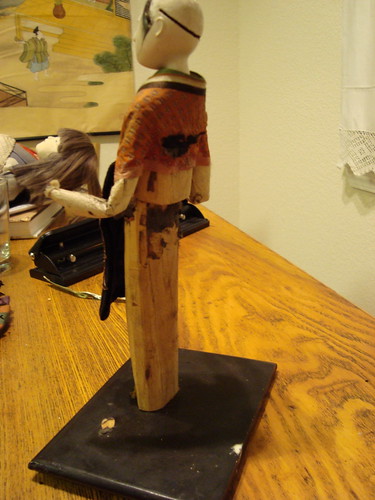 The outer kimono has been taken off in this picture. I've taken off the top outer kimono with the sleeves, and I've taken off the bottom of the kimono, only leaving the bottom three layers of the top kimono. You can see how this doll is constructed. She's made of two dowels, about 1 inch in diameter One is slightly larger to represent her torso, and the part where the obi is tucked under the top of her outer kimono in the back. Her arms are wire, surrounded by batting and wrapped in place with washi paper. You can also see how the doll's hair is inserted, by lining up the ends of the hair in a "hair sheet" and gluing it into the slits cut in the head. This doll's hair would have been upswept into a fashionable hairdo. The "legs" dowel is pegged with a bamboo peg into the lacquered base.
The outer kimono has been taken off in this picture. I've taken off the top outer kimono with the sleeves, and I've taken off the bottom of the kimono, only leaving the bottom three layers of the top kimono. You can see how this doll is constructed. She's made of two dowels, about 1 inch in diameter One is slightly larger to represent her torso, and the part where the obi is tucked under the top of her outer kimono in the back. Her arms are wire, surrounded by batting and wrapped in place with washi paper. You can also see how the doll's hair is inserted, by lining up the ends of the hair in a "hair sheet" and gluing it into the slits cut in the head. This doll's hair would have been upswept into a fashionable hairdo. The "legs" dowel is pegged with a bamboo peg into the lacquered base.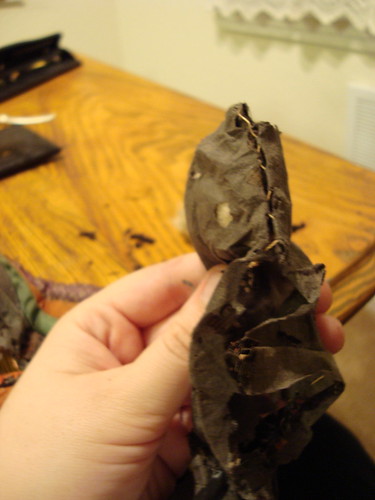
 Finally, here's the lining of the outer kimono. This poor doll is missing her hands which would have been wood and glued to the end of the wire armature finding the core of her arm. You can how the sleeve has been sewn at the top and down the outer edge halfway to leave a hole for her arm. You can see how it's been stitched--the thread is a thick twine, probably paper-based. The sleeve forms a pillow which is stuffed with batting. it is attached to the back of the kimono top, and the other sleeve is attached to the other side, forming a "U" shape. The collar is folded outward and sewn. You can see this around her shoulder.The under kimonos are simply strips that are wrapped around the torso dowell and glued carefully into place.
Finally, here's the lining of the outer kimono. This poor doll is missing her hands which would have been wood and glued to the end of the wire armature finding the core of her arm. You can how the sleeve has been sewn at the top and down the outer edge halfway to leave a hole for her arm. You can see how it's been stitched--the thread is a thick twine, probably paper-based. The sleeve forms a pillow which is stuffed with batting. it is attached to the back of the kimono top, and the other sleeve is attached to the other side, forming a "U" shape. The collar is folded outward and sewn. You can see this around her shoulder.The under kimonos are simply strips that are wrapped around the torso dowell and glued carefully into place.I hope this post has been informative and has perhaps given you ideas for construction of your own pieces. When I get around to rebuilding the kimono, I'll post pictures. If anyone has some nice black kinran that they'd like to share for the reconstruction of the outer kimono, let me know!
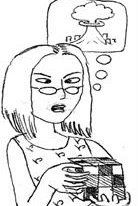
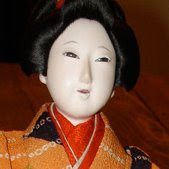
1 comment:
Wow. Scrabcake, you are a legend!
Post a Comment